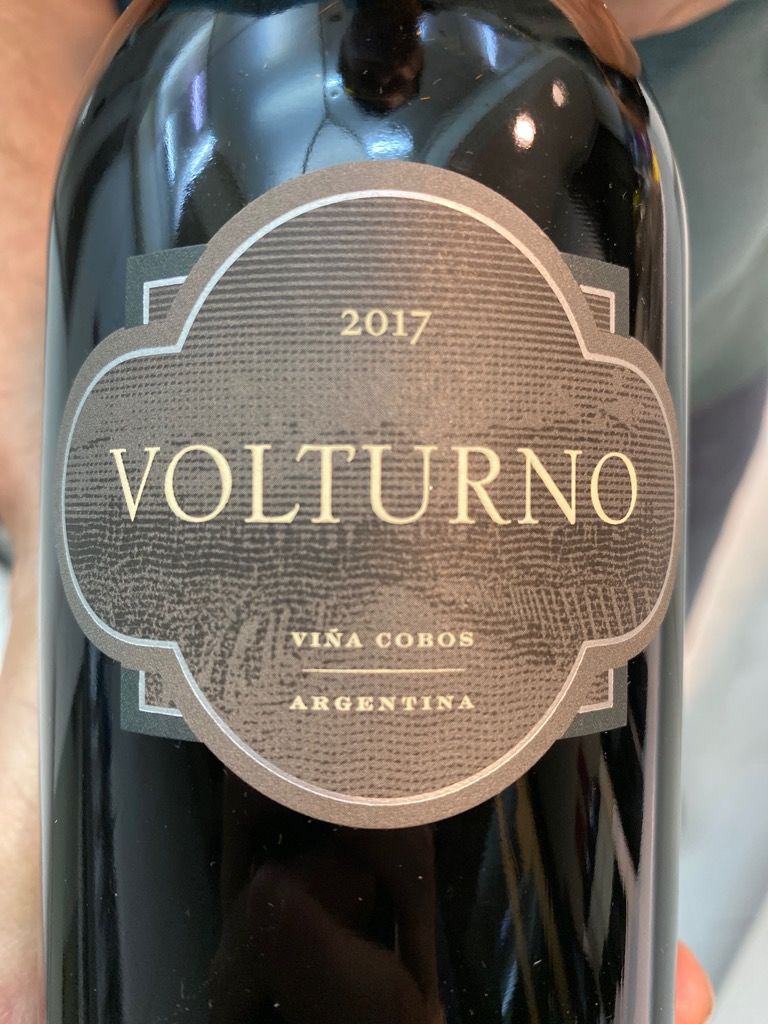
External search
Google (images)
Wine Advocate
Wine Spectator
Burghound
Wine-Searcher
Vintages
2020
2019
2018
2017
2016
2014
2013
2012
2011
2010
2009
2008
2006
2005
2004
2003
2002
1999
N.V.
From this producer
Show all wines
All tasting notes
|
| Drinking Windows and Values |
| Drinking window: Drink between 2024 and 2035 (based on 46 user opinions) |
| Community Tasting History |
| Community Tasting Notes (average 96 pts. and median of 96 pts. in 2 notes) - hiding notes with no text | | | Tasted by DJCRUSE on 3/21/2021: Not Yet Tasted (793 views) |
| By Joaquín Hidalgo
Vinous, Twenty Years that Transformed the Argentine Wine Industry (Oct 2020) (10/1/2020)
(Viña Cobos Volturno Red) Subscribe to see review text. | By Marina Gayan MW
Decanter, South American Red Blends (7/31/2020)
(Viña Cobos, Volturno, Cabernet Sauvignon, Perdriel, Mendoza, Argentina, Red) Subscribe to see review text. | By James Suckling
JamesSuckling.com (2/7/2020)
(Viña Cobos Perdriel Luján de Cuyo Cobos Volturno, Red, Argentina) Subscribe to see review text. |
NOTE: Scores and reviews are the property of Vinous and Decanter and JamesSuckling.com. (manage subscription channels) |
| Viña Cobos Producer website | Importer website
VIÑA COBOS
Uff What a wines!!!!!!!. In this winery work together Marchiory, Barraud and Paul Hobbs...
Nico, who is the owner of the vineyards and Andrea’s father, is also an Italian ambitious man, with an enlightened vision of the future. He is a perseverant man and a truly land-lover who was able to overcome difficult times in the history of Argentinean viticulture always defending the quality of his grapes. Viña Cobos Winery faces the Tupungato, the great mountain whose name means Stone Guard in the indigenous language. The design for our state-of-the-art facility uses large, simple, geometric forms; open space and natural light to complement the majesty of the landscape. At this moment the winery is in its first stage of construction and its current capacity is of 370.000 liters.Red Bordeaux BlendRed Bordeaux is generally made from a blend of grapes. Permitted grapes are Cabernet Sauvignon, Cabernet Franc, Merlot, Petit Verdot, Malbec and rarely Carménère.Today Carménère is rarely used, with Château Clerc Milon, a fifth growth Bordeaux, being one of the few to still retain Carménère vines. As of July 2019, Bordeaux wineries authorized the use of four new red grapes to combat temperature increases in Bordeaux. These newly approved grapes are Marselan, Touriga Nacional, Castets, and Arinarnoa.
Wineries all over the world aspire to making wines in a Bordeaux style. In 1988, a group of American vintners formed The Meritage Association to identify wines made in this way. Although most Meritage wines come from California, there are members of the Meritage Association in 18 states and five other countries, including Argentina, Australia, Canada, Israel, and Mexico.Argentina Wines of Argentina
Argentina has been making wine since the 1500s, tracing its wine heritage back to Spain, France and, perhaps surprisingly, Italy. Italian immigration is second only to Spanish in Argentine culture, and the flavors of Italy show up strongly in the nation’s wine, food and cultural tradition. Historically, Argentina has kept much of its wine consumption at home, drinking most of the wine it makes. But we are now seeing more very serious Argentine wines north of the border, and Malbec is leading the movement. The wine-making region in Argentina ranges between the 22° and 42° South latitude. It spreads at the foothills of the Andean mountain range along over 2,400 km; from the province of Salta to the province of Río Negro, with a variety of climates and soils that makes each region a unique land. In general terms, the areas dedicated to vine cultivation are dry and arid with a low level of rain and humidity, determining factor as regards grape health. Abundant sunny days and thermal amplitude favor a good maturity and concentration of aroma and color in the grain. Soils are deep, permeable and poor in organic matter, decisive qualities at the time of obtaining good wine. Due to the low rain regime, irrigation is necessary. Water comes from the Andean range thaw, descending in the shape of rivers to become channels or ditches. Undoubtedly, the combination of these factors turns Argentina into a veritable oasis for the highest quality wine-making. Nevertheless, there is still a long way to go. Wine-making in Argentina, at the level that it achieves today, has a young history that goes back to a little more than 10 years ago. Technological progress, investment and some farsighted businessmen enabled a determining transformation. The province of Mendoza is the most traditional area in the viticultural industry, and is diverse enough to be divided into zones, according to their significantly different weather, height and soil characteristics. These include the Northern Zone, which is suitable for fruity whites and young reds, at a height from 600 to 700m; the Eastern Zone, with a height ranging from 600 to 700m, and the most productive zone in the province; the Uco Valley, a zone of colder weather and higher altitudes (between 800 and 1,400m over sea level); San Rafael, with heights ranging from 450 to 800m; and the High Zone of the Mendoza River, with heights ranging from 800 to 1,100m over sea level and various microclimates, this is the zone where almost all noble varieties have easily become adapted. It is a region that is remarkably well-suited to vine culture, protected from the Pacific’s cooling influence by the Andes and enjoying a long summer of cool nights and warm days, with a dry summer climate but plenty of water available from the region’s rivers. Malbec in particular is outstanding from this area, and it has clearly emerged as the star, the darling of both consumers and critics.Mendoza Wines of Mendoza |
|




